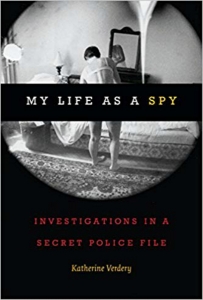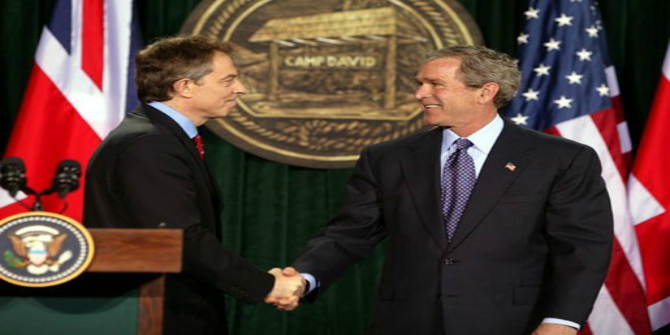In My Life as a Spy: Investigations in a Secret Police File, Katherine Verdery offers insight into the history of communism in Romania by exploring the surveillance file created on her by the Romanian secret police (the Securitate), analysing the documents produced through the operation and the role played by informers and officers. The book will help readers to better understand the process by which ‘enemies of the state’ were constructed as well as the intimate experience of confronting this history, finds Vlad Onaciu.
My Life as a Spy: Investigations in a Secret Police File. Katherine Verdery. Duke University Press. 2018.
Nearly three decades have passed since the fall of the communist regimes in Europe and the crumbling of the Soviet Union. The scholars whose work had focused on this part of the world have now reached the full maturity of their intellectual selves, and many have decided to share their experiences. One of these is Katherine Verdery, who in her most recent book, My Life as a Spy, has written about the surveillance file that the Romanian secret police (the Securitate) created on her. As she admits, this is not a purely academic endeavour, but also an ‘(auto)biographical’ one, in which she views her past through the lens of others.
Verdery is one of the most renowned Western scholars on the history of Romanian communism. As an anthropologist, she began studying the political economy of social inequality, ethnic relations and nationalism, and ended up looking at the transformative phenomena of socialist systems in The Vanishing Hectare, Peasants under Siege and What Was Socialism?. Her background in anthropology is a great influence on her new book, as she turns the people mentioned in the text into living characters and not the mere subjects of history, bringing a much-appreciated human touch. She also tries to recreate the social context, the stage on which these actors enacted their roles.
There are two aspects of My Life as a Spy that come to the attention of any reader. Firstly, how the Securitate operated, how they moved in creating the enemies of the state: new, more dangerous selves for the individuals they had under surveillance. Secondly, the experience of confronting this reality: how Verdery reacts to seeing her file and how she was portrayed, while also confronting those who kept her under watch and those who had betrayed her intimacy and trust.
 Image Credit: (Pixabay CC0)
Image Credit: (Pixabay CC0)
As a PhD student, Verdery chose to do research in a village near the town of Cugir in Alba County, due to its ethnic diversity. Unbeknownst to her, it was in the proximity of a weapons factory, something that was not public knowledge at the time. So, in 1970, while riding her motorcycle, she ended up in a restricted area and was picked up by local police, who informed their superiors. The Securitate decided that she was most probably a military spy and opened a file on her, thus creating her first self: ‘The Folklorist’, a nickname chosen because she told them she was studying the traditions of people living in that area. She became the subject of surveillance because she was a US citizen asking civilians about the social and economic aspects of their lives. In the eyes of the secret police, this made her potentially dangerous. Verdery ends up exploring this aspect through conversations with some of the officers, in the hope of understanding how they constructed the image of enemies of the state.
The second self was born from her name, ‘Verdery’, which the communist authorities suspected was of Hungarian origin (in reality, it came from French). This happened during the time she spent in Cluj in the 1980s. This interpretation of her name was seen as problematic given the possible ethnic tensions in Transylvania. This was further aggravated by the use of jokes about Romanians, Saxons and Hungarians in her first book, which brought about even more suspicion. This, in fact, had put quite a strain on her relationships with professors in Romania, especially with academic David Prodan.
The third self, ‘Vera’, followed her back home (1987-88). It seems that the Securitate had planned to sue her for spying against Romania. These actions were taken after Verdery had returned to the USA and seem to have been born out of the desperation of the regime, which by the late 1980s had lost most of its international credibility and sympathy as a dissident state. All of these three identities were given attributes that served the interests of the secret police in painting the picture of a mal-intentioned individual who must be fought against.
By looking at how the Securitate constructed identities for their subjects, Verdery offers a precious and rare insight into how they operated. In her case, they proceeded to recruit individuals that were close to her, that had become friends or even akin to family. Yet this was not enough, as the mere truth would never have served the purposes of the surveillance files. Thus, the Securitate officers taught these people what to write and how to write it, how to speak their language. This was tied to how the regime used social networks: how they manipulated the relationships between people so as to get what they wanted from them.
Given that this book has a strong autobiographical character, it also recounts the experience of confronting one’s informers and officers. This is quite a unique experience for each individual. Verdery presents it as a difficult task, not only for her, but also for those brought under her own questioning. This involved coming to terms with the lies told in the file and the breach of normal human relationships. For other intellectuals who have faced similar experiences, this endeavour took on a more relaxed nuance. One such example, given by Verdery herself, is that of Romanian philosopher, Gabriel Liiceanu, who was more comfortable in confronting those who had betrayed him. However, going through his book, My Dear Snitch, one will still find the same shock of discovering how close these individuals had been.
Verdery recounts her meetings and conversations with those who had informed on her activities and tries to understand why they had done so, although the extent of her success in this respect is debatable. There are two types of individuals she focuses her attention on in this section. The first comprises her friends or those she even considered to be family. In this respect, the most striking example is that of ‘Beniamin’, with whom she could barely come into contact as he avoided her. This helped her better understand what those who had ended up as informers experienced before and after the fall of communism. The second category is comprised of the officers whose mission she had become. This proved to be a somewhat more difficult task, and her first attempts in 2005 were unsuccessful, but by the early 2010s, people had become more open. She eventually met one officer, ‘Grigorescu’, and the experience was shocking for her, as he did not seem to have hated her then, even less so now. In this regard, she draws on the conclusions of Hannah Arendt regarding the banality of evil and is left with the question of ‘how evil was the Securitate?’.
There have been many scholarly efforts at explaining how the Securitate worked (see, for example, Dennis Deletant, Ceausescu and the Securitate; and Cristina Vatulescu, Police Aesthetics), but these offer broader explanations for its mechanisms. Verdery’s My Life as a Spy offers an analysis of the documents one surveillance operation generated and the role played by both informers and officers. This postmodern approach is valuable, yet there are certain limits to this, as it is just one case and it would be quite difficult to generalise on her conclusions for all such documents. Verdery had the advantage of confronting some of the officers, which constitutes one of the most essential contributions of her book, as it helps us understand how the enemy of the regime was constructed during the second phase of communism and how the authorities dealt with them.
Vlad Onaciu is a PhD student in the Faculty of History and Philosophy at Babes-Bolyai University, where he previously finished his BA and MA in contemporary history. His doctoral research focuses on issues regarding the lives of workers in factories during the communist regime in Romania. His academic interests include the history of communism, oral history, international relations (mainly civilisational studies) and nineteenth- and twentieth-century history in general. Read more by Vlad Onaciu.
Note: This review gives the views of the author, and not the position of the LSE Review of Books blog, or of the London School of Economics.


 Find this book:
Find this book: 




